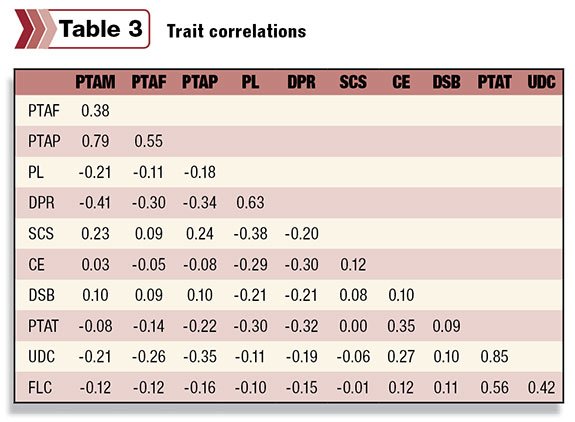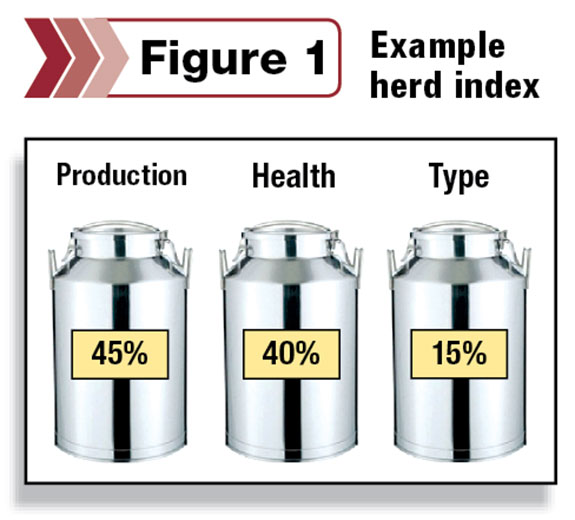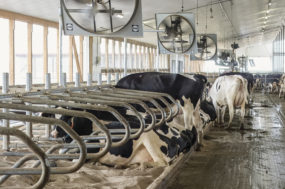Stature, rump angle, teat length, teat placement – do they impact longevity and reproduction? In this article, we’ll look at these four linear type traits often thought to impact performance. Perception is not always reality, so we look to the data to find the true answers.
Genetic correlations
Simply put, a genetic correlation is a measurement of the relationship between traits. When relationship is high, selection for one trait causes a correlated trait to also change substantially, and when relationship is low, or uncorrelated, selection for one trait has no impact on other traits.
In this analysis, we looked at a dataset of all bulls with more than 100 daughters which entered A.I. in the past 10 years.
For example, the correlation between PTAM and PTAP is 0.79, indicating selection for either of these traits will result in an increase in the other. Effectively, this means that selection exclusively for PTAM will give you 79 percent of the genetic progress for PTAP that was possible if PTAP was exclusively selected for.
Alternatively, the correlation between daughter pregnancy rate (DPR) and Dairy Form is -0.50, meaning selection for one of these traits will result in a decrease in the other.
This should be no surprise as thin, dairy-looking cows are often in negative energy balance and therefore more difficult to get pregnant than those carrying some condition.
Lastly, the correlation between stature and PTAM is 0.00, meaning selection for one of these traits has no influence on the other, or that bigger cows don’t produce differently than smaller cows.
Genetic correlations matter because they can affect the outcome of your breeding goals. While you may think you’re selecting for a desirable trait, keep in mind that the trait may be correlated with something you consider to be undesirable.
Phenotypic impact of linear trait selection
Stature
Feedback from clients around the world confirms Holstein cows are getting bigger and taller, and as a result, don’t fit into stalls, parlors, etc. Most commercial breeders agree Holsteins would last longer and cost less to maintain if they were somewhat smaller.
In addition to being highly heritable, stature is highly correlated with other type traits, including PTAT, UDC and FLC. This means selection for any one of these type composites will result in taller cows – and quickly.
On the other hand, stature is negatively correlated with economically important traits productive life (PL) and DPR, meaning selection for stature results in a decrease in these traits and vice versa.
This leads some producers to select for smaller (lower stature or negative stature) bulls. However, is this the right approach, when the real goal is longer-lasting cows?
As you see from Table 1 , the stature difference between a bull that is 0 and another bull that is +2 is only 
0.7 inches (1.8 cm).
Click here or on the image at right to view it at full size in a new window.
By forcing stature to be low (and gaining only a small amount), we can easily overlook the real selection goal.
 Click here or on the image at right to view it at full size in a new window.
Click here or on the image at right to view it at full size in a new window.

Rump angle
Rump angle is often thought to affect fertility and calving ease.
The theory behind this perception would be hard to argue with if we didn’t have data; however, there is no meaningful correlation between rump angle and PL or DPR ( Tables 3 and 4 ).
The trait simply doesn’t affect longevity or fertility – despite preconceived ideas.
Let’s look at an example with two bulls. Say you have 100 daughters by Bull A and 100 daughters by Bull B. Bull A is +1.5 for rump 
angle and Bull B is -0.3 for the same trait.
Click here or on the image at right to view it at full size in a new window.
You have a lot of time on your hands and want to see how this difference in proof for rump angle translates into a measurement in inches (Table 1), so you measure the rump angles of these 200 cows.
You discover that, on average, Bull B daughters have higher pins than the Bull A daughters (by only about 0.4 of an inch) – just as the proofs told us.
Still, despite this rump angle difference, daughters of Bull B get pregnant just as quickly as daughters of Bull A (DPR = +1.5 for both).
Regardless of perceptions, the data proves pin setting doesn’t have an impact on daughter fertility. From the above example, we can also conclude there is minimal (0.4 inch) difference in the realized average pin setting between a sire that is +1.5 and -0.3 for rump angle.
Many producers express frustration and concern about subpar reproductive performance. However, we now know the slope from hips to pins is not the cause of our reproductive shortcomings.
If fertility is of concern, select directly for the desired trait (DPR) instead of for a trait which is only perceived to impact fertility.
Teat length and rear teat placement
Selection for rear teat placement, combined with selection for a strong udder cleft, has resulted in rear teats placed very closely together, or in some instances, crossing.
It is often speculated that cows with close rear teats, long teats or short teats aren’t kept as long as cows with moderate-sized teats placed squarely beneath each quarter. Yet when the correlations between these traits and productive life are examined, the influence is negligible.
Further, when we analyze the realized phenotypic difference of daughter groups of two bulls, we can see that the difference between daughters of a bull that is 0 for rear teat placement and a daughter that is -2 is only 0.27 inches (Table 1).
Perceptions versus true management issues
Does stature affect DPR and PL? Yes – we learned it does. Selection for stature leads to decreased fertility and longevity, causing true management issues.
Do rump angle, teat length and rear teat placement affect DPR and PL? No – the data simply doesn’t support this perception. These traits are only perceived to affect the productive life and reproductive capabilities of the cow.
When looking at genetic correlations among traits, the good news is that for the most part, health traits are correlated with each other, as are the production traits and the conformation traits.
When creating a genetic plan for your own herd, divide your weights among the production, health and conformation “buckets,” as opposed to focusing on individual trait cutoffs.
Example herd index

Five bulls were selected according to the genetic plan outlined in Figure 1 .
The group of five bulls best suiting this plan possesses impressive trait averages for the areas of interest: 119 pounds CFP, +1.4 DPR and +7.3 PL.
Included in the group of bulls for this plan is Bull C. This bull is an ideal match for the plan outlined in Figure 1 as he excels for both production and health traits.
However, Bull C daughters will tend to have short teats (-1.95 teat length or around 2.27-inch teats).
So should Bull C be removed from the group? If we were to replace him with the next bull according to our herd genetic plan that is positive for teat length, we’d replace Bull C with Bull D (+0.11 TL).
Would this replacement be a smart move for this genetic plan? Definitely not – the fact that Bull C will transmit shorter teats is not proven to affect his longevity.
Use a mating program to ensure cows with short teats aren’t bred to Bull C instead of eliminating him from the genetic plan. Excluding Bull C in favor of another bull with longer teats, but not as high for our selected genetic plan, will cost us genetic progress.
The bottom line
Certain linear type traits affect performance, but breeder beware – traits which truly have an impact on longevity and reproduction may not be those you perceive.
Instead of focusing on individual traits, create a herd genetic plan by assigning weights to production, health and conformation “buckets.” This way, you’ll be sure to achieve rapid progress towards the traits most important and valuable to you. PD
Nate Zwald is the senior director of global strategy and marketing with Alta Genetics.

Nate Zwald
Senior Director of Global Strategy and Marketing
Alta Genetics






